Inversion of Crop Water Content Using Multispectral Data and Machine Learning Algorithms in the North China Plain
Abstract
1. Introduction
2. Materials and Methods
2.1. Site Description
2.2. Experimental Design
2.3. Data Collection and Processing
2.4. Calculation of Vegetation Indices
2.5. Measurement of Crop Water Content (CWC)
2.6. Machine Learning Algorithms
2.6.1. Multiple Linear Regression (MLR)
2.6.2. Random Forest (RF)
2.6.3. Ridge Regression
2.6.4. ElasticNet Regression
2.6.5. Partial Least Squares Regression (PLSR)
2.7. Dataset Description
2.8. Model Evaluation Metrics
2.9. Statistical Analysis
3. Results
3.1. Correlation Analysis between Vegetation Indices and CWC
3.2. Vegetation Indices at the Flowering Stage
3.3. Correlation Analysis between Predicted and Observed CWC
3.4. Model Evaluation
3.5. Construction of CWC Inversion Maps Based on GNDVI and NDRE Using the RF Model
4. Discussion
4.1. Identification of Optimal Vegetation Indices for CWC Estimation
4.2. Identification of Optimal Machine Learning Algorithms for CWC Estimation
5. Conclusions
Author Contributions
Funding
Data Availability Statement
Acknowledgments
Conflicts of Interest
References
- Yuan, G.F.; Tang, D.Y.; Luo, Y.; Yu, Q. Advances in Crop Water Stress Research Based on Canopy Temperature. Adv. Earth Sci. 2001, 16, 45–54, (In Chinese with English Abstract). [Google Scholar]
- Xue, L.H.; Cao, W.X.; Tian, Y.C. Advances in Spectral Diagnosis of Crop Water and Nitrogen Status. J. Remote Sens. 2003, 7, 73–80. [Google Scholar]
- Cheng, T.; Rivard, B.; Sanchez-Azofeifa, A.G.; Féret, J.-B.; Jacquemoud, S.; Ustin, S.L. Predicting Leaf Gravimetric Water Content from Foliar Reflectance across a Range of Plant Species Using Continuous Wavelet Analysis. J. Plant Physiol. 2012, 169, 1134–1142. [Google Scholar] [CrossRef] [PubMed]
- Yu, J.; Zhang, S.; Zhang, Y.; Hu, R.; Lawi, A.S. Construction of a Winter Wheat Comprehensive Growth Monitoring Index Based on a Fuzzy Degree Comprehensive Evaluation Model of Multispectral UAV Data. Sensors 2023, 23, 8089. [Google Scholar] [CrossRef]
- Feng, H.; Tao, H.; Li, Z.; Yang, G.; Zhao, C. Comparison of UAV RGB Imagery and Hyperspectral Remote-Sensing Data for Monitoring Winter Wheat Growth. Remote Sens. 2022, 14, 3811. [Google Scholar] [CrossRef]
- Pei, H.; Feng, H.; Li, C.; Jin, X.; Li, Z.; Yang, G. Remote Sensing Monitoring of Winter Wheat Growth with UAV Based on Comprehensive Index. Trans. Chin. Soc. Agric. Engin. 2017, 33, 74–82, (In Chinese with English Abstract). [Google Scholar]
- Wen, S.; Liu, Z.; Han, Y.; Chen, Y.; Xu, L.; Li, Q. Spatiotemporal Variation Characteristics of Reference Evapotranspiration and Relative Moisture Index in Heilongjiang Investigated through Remote Sensing Tools. Remote Sens. 2023, 15, 2582. [Google Scholar] [CrossRef]
- Zheng, W.; Zhang, J.; He, Y.; Liu, H.; Chen, M. A Review of Vegetation Indices and Their Application in Remote Sensing of Crop Water Content. Agric. Water Manag. 2023, 279, 107903. [Google Scholar] [CrossRef]
- Cassanelli, D.; Lenzini, N.; Ferrari, L.; Rovati, L. Partial Least Squares Estimation of Crop Moisture and Density by Near-Infrared Spectroscopy. IEEE Trans. Instrum. Meas. 2021, 70, 1004510. [Google Scholar] [CrossRef]
- Li, C.; Wang, Y.C.; Li, X.Q.; Yang, X.F.; Gu, X.H. Estimation Model of Wheat Plant Component Moisture Content Based on Wavelet Technology. J. Agric. Mach. 2021, 52, 193–201. [Google Scholar] [CrossRef]
- Torres-Tello, J.W.; Ko, S. A Novel Approach to Identify the Spectral Bands That Predict Moisture Content in Canola and Wheat. Biosyst. Eng. 2021, 210, 91–103. [Google Scholar] [CrossRef]
- Han, G. Research on Wheat Plant Water Status Monitoring Based on Hyperspectral Data. Ph.D. Thesis, Northwest A&F University, Yangling, China, 2011. [Google Scholar]
- Wang, Q.; Yi, Q.X.; Bao, A.M.; Zhao, J. Study on Hyperspectral Indices for Estimating Cotton Canopy Water Content. Spectrosc. Spect. Anal. 2013, 33, 507–512. [Google Scholar] [CrossRef]
- Jiang, J.; Liu, D.; Zheng, Z.; Shi, Y.; Wang, L. Evaluating the Performance of Machine Learning Models for Predicting Crop Water Stress Using Sentinel-2 Data. Agric. Water Manag. 2023, 274, 107964. [Google Scholar] [CrossRef]
- Yang, C.; Cheng, J.; Liu, B.; Zhang, W.; Huang, J. Assessment of the Potential of Machine Learning Approaches for Estimating Crop Water Status Using Multi-Source Remote Sensing Data. Remote Sens. Appl. Soc. Environ. 2024, 29, 100581, (In Chinese with English Abstract). [Google Scholar]
- Zhang, Y.W.; Wang, S.M.; Chen, D.; Wang, Y.; Fu, H. Detection Methods of Wheat Plant Water Content Based on Near-Infrared Reflectance. J. Agric. Mach. 2017, 48 (Suppl. S1), 118–122+261, (In Chinese with English Abstract). [Google Scholar]
- Habure, T.; Zhang, B.Z.; Li, S.E.; Peng, Z.G.; Han, N.N.; Liu, L.L. Diagnosis of Winter Wheat Plant Water Content Based on Canopy Spectral Characteristics. Irrig. Drain. 2018, 37, 9–15, (In Chinese with English Abstract). [Google Scholar]
- Ndlovu, H.S.; Odindi, J.; Sibanda, M.; Mutanga, O.; Clulow, A.; Chimonyo, V.G.P.; Mabhaudhi, T. A Comparative Estimation of Maize Leaf Water Content Using Machine Learning Techniques and Unmanned Aerial Vehicle (UAV)-Based Proximal and Remotely Sensed Data. Remote Sens. 2021, 13, 4091. [Google Scholar] [CrossRef]
- Han, D.; Liu, S.; Du, Y.; Xie, X.; Fan, L.; Lei, L.; Li, Z.; Yang, H.; Yang, G. Crop Water Content of Winter Wheat Revealed with Sentinel-1 and Sentinel-2 Imagery. Sensors 2019, 19, 4013. [Google Scholar] [CrossRef]
- Hassan-Esfahani, L.; Torres-Rua, A.; Jensen, A.; McKee, M. Assessment of Surface Soil Moisture Using High-Resolution Multi-Spectral Imagery and Artificial Neural Networks. Remote Sens. 2015, 7, 2627–2646. [Google Scholar] [CrossRef]
- Chen, S.B.; Chen, J.Y.; Zhang, Z.T.; Bian, J.; Wang, Y.F.; Shi, S.L. Estimation of Soil Moisture Content in Winter Wheat at the Booting Stage Using UAV Multispectral Remote Sensing. Water Saving Irrig. 2018, 22, 39–43, (In Chinese with English Abstract). [Google Scholar]
- Chen, J.Y.; Chen, S.B.; Zhang, Z.T.; Fu, Q.P.; Bian, J.; Cui, T. Estimation of Cotton Photosynthetic Parameters at the Budding Stage Using UAV Multispectral Remote Sensing. J. Agric. Mach. 2018, 49, 230–239. [Google Scholar] [CrossRef]
- Mndela, Y.; Ndou, N.; Nyamugama, A. Irrigation Scheduling for Small-Scale Crops Based on Crop Water Content Patterns Derived from UAV Multispectral Imagery. Sustainability 2023, 15, 12034. [Google Scholar] [CrossRef]
- Wang, X.; Wang, Z.; Xu, L.; Liu, H.; Zhang, L. Evaluation of Vegetation Indices for Monitoring Crop Water Stress in the North China Plain. Field Crops Res. 2024, 287, 108847. [Google Scholar] [CrossRef]
- Huete, A.R. A Soil-Adjusted Vegetation Index (SAVI). Remote Sens. Environ. 1988, 25, 295–309. [Google Scholar] [CrossRef]
- Wang, Z.; Liu, C.; Huete, A.R. Advances in Vegetation Index Research from AVHRR-NDVI to MODIS-EVI. Acta Ecol. Sin. 2003, 23, 1649–1661. [Google Scholar]
- Gitelson, A.A.; Gritz, Y.; Merzlyak, M.N. Relationships Between Leaf Chlorophyll Content and Spectral Reflectance and Algorithms for Non-Destructive Chlorophyll Assessment in Higher Plant plant. J. Plant Physiol. 2003, 160, 271–282. [Google Scholar] [CrossRef]
- Barnes, E.M.; Clarke, T.; Richards, S.E.; Colaizzi, P.D.; Haberland, J.; Kostrzewski, M.; Waller, P.; Choi, C.; Riley, E.; Thompson, T.; et al. Coincident Detection of Crop Water Stress, Nitrogen Status, and Canopy Density Using Ground-Based Multispectral Data. In Proceedings of the 4th International Conference on Precision Agriculture, Minneapolis, MN, USA, 16–19 July 2000. [Google Scholar]
- Cao, Q.; Miao, Y.; Shen, J.; Yu, W.; Yuan, F.; Cheng, S.; Huang, S.; Wang, H.; Yang, W.; Liu, F. Improving In-Season Estimation of Rice Yield Potential and Responsiveness to Topdressing Nitrogen Application with Crop Circle Active Crop Canopy Sensor. Precis. Agric. 2015, 17, 136–154. [Google Scholar] [CrossRef]
- Gilabert, M.A.; González-Piqueras, J.; García-Haro, F.J.; Meliá, J. A Generalized Soil-Adjusted Vegetation Index. Remote Sens. Environ. 2002, 82, 303–310. [Google Scholar] [CrossRef]
- Lu, J.; Miao, Y.; Shi, W.; Li, J.; Yuan, F. Evaluating Different Approaches to Non-Destructive Nitrogen Status Diagnosis of Rice Using Portable RapidSCAN Active Canopy Sensor. Sci. Rep. 2017, 7, 14073. [Google Scholar] [CrossRef]
- Gitelson, A.A.; Kaufman, Y.J.; Merzlyak, M.N. Use of a Green Channel in Remote Sensing of Global Vegetation from EOS-MODIS. Remote Sens. Environ. 1996, 58, 289–298. [Google Scholar] [CrossRef]
- Rouse, J.W.; Haas, R.H.; Deering, D.W.; Schell, J.A.; Harlan, J.C. Monitoring the Vernal Advancement and Retrogradation (Green Wave Effect) of Natural Vegetation. In Proceedings of the Third Earth Resources Technology Satellite-1 (ERTS-1) Symposium, Washington, DC, USA, 10–14 December 1973. [Google Scholar]
- Schuerger, A.C.; Capelle, G.A.; Di Benedetto, J.A.; Mao, C.; Thai, C.N.; Evans, M.D.; Richards, J.T.; A Blank, T.; Stryjewski, E.C. Comparison of Two Hyperspectral Imaging and Two Laser-Induced Fluorescence Instruments for the Detection of Zinc Stress and Chlorophyll Concentration in Bahia Grass (Paspalum notatum Flugge). Remote Sens. Environ. 2003, 84, 572–588. [Google Scholar] [CrossRef]
- Jordan, C.F. Derivation of Leaf-Area Index from Quality of Light on the Forest Floor. Ecology 1969, 50, 663–666. [Google Scholar] [CrossRef]
- Deering, D.W.; Rouse, J.W.; Haas, R.H.; Schell, J.A. Measuring “Forage Production” of Grazing Units from Landsat MSS Data. In Proceedings of the Second Earth Resources Technology Satellite-1 (ERTS-1) Symposium, Washington, DC, USA, 6 October 1975. [Google Scholar]
- Guo, X.; Liu, X.; Song, G. Multiple Linear Regression Analysis. In Textbook of Medical Statistics.; Guo, X., Xue, F., Eds.; Springer: Singapore, 2024. [Google Scholar] [CrossRef]
- Chakraborty, A.; Goswami, D. Prediction of slope stability using multiple linear regression (MLR) and artificial neural network (ANN). Arab. J. Geosci. 2017, 10, 385. [Google Scholar] [CrossRef]
- Elsherbiny, O.; Fan, Y.; Zhou, L.; Qiu, Z. Fusion of Feature Selection Methods and Regression Algorithms for Predicting the Canopy water Content of Rice Based on Hyperspectral Data. Agriculture 2021, 11, 51. [Google Scholar] [CrossRef]
- Zhang, Y.; Liu, J.; Shen, W. A Review of Ensemble Learning Algorithms Used in Remote Sensing Applications. Appl. Sci. 2022, 12, 8654. [Google Scholar] [CrossRef]
- Chan, J.Y.L.; Leow, S.M.H.; Bea, K.T.; Cheng, W.K.; Phoong, S.W.; Hong, Z.W.; Chen, Y.L. Mitigating the Multicollinearity Problem and Its Machine Learning Approach: A Review. Mathematics 2022, 10, 1283. [Google Scholar] [CrossRef]
- Muthukrishnan, R.; Rohini, R. LASSO: A feature selection technique in predictive modeling for machine learning. In Proceedings of the 2016 IEEE International Conference on Advances in Computer Applications (ICACA), Coimbatore, India, 24 October 2016; pp. 18–20. [Google Scholar] [CrossRef]
- Rauschenberger, A.; Glaab, E.; van de Wiel, M.A. Predictive and interpretable models via the stacked elastic net. Bioinformatics 2021, 37, 2012–2016. [Google Scholar] [CrossRef]
- Srivatsaan, S.; Sankar, A.; Karthikeyan, M. Impact of elastic net and LASSO regularization techniques on the NHANES dataset. AIP Conf. Proc. 2024, 3075, 020208. [Google Scholar] [CrossRef]
- Boulesteix, A. PLS Dimension Reduction for Classification with Microarray Data. Stat. Appl. Genet. Mol. 2004, 3, 33. [Google Scholar] [CrossRef]
- Kvalheim, O.M.; Arneberg, R.; Bleie, O.; Rajalahti, T.; Smilde, A.K.; Westerhuis, J.A. Variable importance in latent variable regression models. J. Chemom. 2014, 28, 615–622. [Google Scholar] [CrossRef]
- Askari, M.S.; O’Rourke, S.M.; Holden, N.M. Evaluation of soil quality for agricultural production using visible–near-infrared spectroscopy. Geoderma 2015, 243, 80–91. [Google Scholar] [CrossRef]
- Peng, Z.; Lin, S.; Zhang, B.; Wei, Z.; Liu, L.; Han, N.; Cai, J.; Chen, H. Winter wheat canopy water content monitoring based on spectral transforms and “three-edge” parameters. Agric. Water Manag. 2020, 240, 106306. [Google Scholar] [CrossRef]
- Liu, L.; Wang, J.; Huang, W.; Zhao, C.; Zhang, B.; Tong, Q. Estimating winter wheat plant water content using red edge parameters. Int. J. Remote Sens. 2004, 25, 3331–3342. [Google Scholar] [CrossRef]
- Kapari, M.; Sibanda, M.; Magidi, J.; Mabhaudhi, T.; Nhamo, L.; Mpandeli, S. Comparing Machine Learning Algorithms for Estimating the Maize Crop Water Stress Index (CWSI) Using UAV-Acquired Remotely Sensed Data in Smallholder Croplands. Drones 2024, 8, 61. [Google Scholar] [CrossRef]
- Yin, C.; Wang, Z.; Lv, X.; Qin, S.; Ma, L.; Zhang, Z.; Tang, Q. Reducing soil and leaf shadow interference in UAV imagery for cotton nitrogen monitoring. Front. Plant Sci. 2024, 15, 1380306. [Google Scholar] [CrossRef]
- Dong, T.; Liu, J.; Shang, J.; Qian, B.; Ma, B.; Kovacs, J.M.; Walters, D.; Jiao, X.; Geng, X.; Shi, Y. Assessment of red-edge vegetation indices for crop leaf area index estimation. Remote Sens. Environ. 2019, 222, 133–143. [Google Scholar] [CrossRef]
- Kyratzis, A.C.; Skarlatos, D.P.; Menexes, G.C.; Vamvakousis, V.F.; Katsiotis, A. Assessment of vegetation indices derived by UAV imagery for durum wheat phenotyping under a water limited and heat stressed Mediterranean environment. Front. Plant Sci. 2017, 8, 1114. [Google Scholar] [CrossRef]
- Xu, Q.; Hu, Z.; Chen, Z.; Li, Q.; Zhao, Y. Application of Random Forest and Support Vector Machine for Estimating Crop Water Content Using High-Resolution Remote Sensing Data. Comput. Electron. Agric. 2024, 194, 106748. [Google Scholar] [CrossRef]
- Al-Jarrah, O.Y.; Yoo, P.D.; Muhaidat, S.; Karagiannidis, G.K.; Taha, K. Efficient machine learning for big data: A review. Big Data Res. 2015, 2, 87–93. [Google Scholar] [CrossRef]
- Ahmad, M.W.; Reynolds, J.; Rezgui, Y. Predictive modelling for solar thermal energy systems: A comparison of support vector regression, random forest, extra trees and regression trees. J. Clean. Prod. 2018, 203, 810–821. [Google Scholar] [CrossRef]
- Zebari, R.; Abdulazeez, A.; Zeebaree, D.; Zebari, D.; Saeed, J. A comprehensive review of dimensionality reduction techniques for feature selection and feature extraction. J. Appl. Sci. Technol. Trends 2020, 1, 56–70. [Google Scholar] [CrossRef]
- Hu, T.; Zhang, X.; Bohrer, G.; Liu, Y.; Zhou, Y.; Martin, J.; Li, Y.; Zhao, K. Crop yield prediction via explainable AI and interpretable machine learning: Dangers of black box models for evaluating climate change impacts on crop yield. Agr. Forest Meteorol. 2023, 336, 109458. [Google Scholar] [CrossRef]
- Hussain, J.N. High dimensional data challenges in estimating multiple linear regression. J. Phys. Conf. Series. 2020, 1591, 012035, (IOP Publishing). [Google Scholar] [CrossRef]
- Alsouki, L. Functional data regression with prediction and interpretability: Property inference in chemometrics with sparse Partial Least Squares (PLS). Ph.D. Thesis, Université Claude Bernard-Lyon I, Lyon, France, Université Saint-Joseph (Beyrouth), Beirut, Lebanon, 2023. [Google Scholar]
- Guo, L. Extreme Learning Machine with Elastic Net Regularization. Intell. Autom. Soft Comput. 2020, 26, 421–427. [Google Scholar] [CrossRef]
- Tay, J.K. Extending the Reach of the Lasso and Elastic Net Penalties: Methodology and Practice. Ph.D. Thesis, Stanford University, Stanford, CA, USA, 2021. [Google Scholar]
- Fei, S.; Hassan, M.A.; He, Z.; Chen, Z.; Shu, M.; Wang, J.; Li, C.; Xiao, Y. Assessment of Ensemble Learning to Predict Wheat Grain Yield Based on UAV-Multispectral Reflectance. Remote Sens. 2021, 13, 2338. [Google Scholar] [CrossRef]
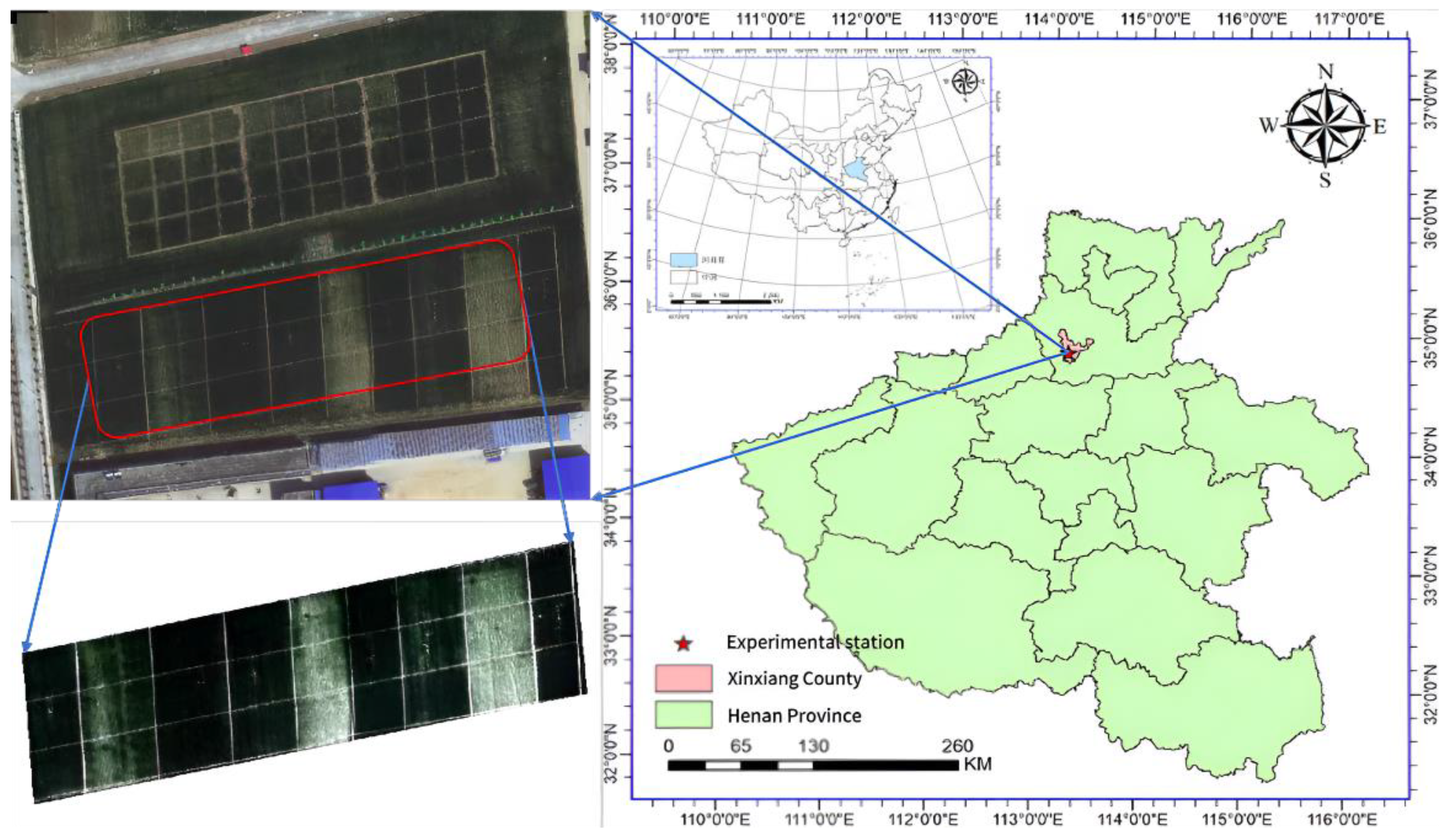
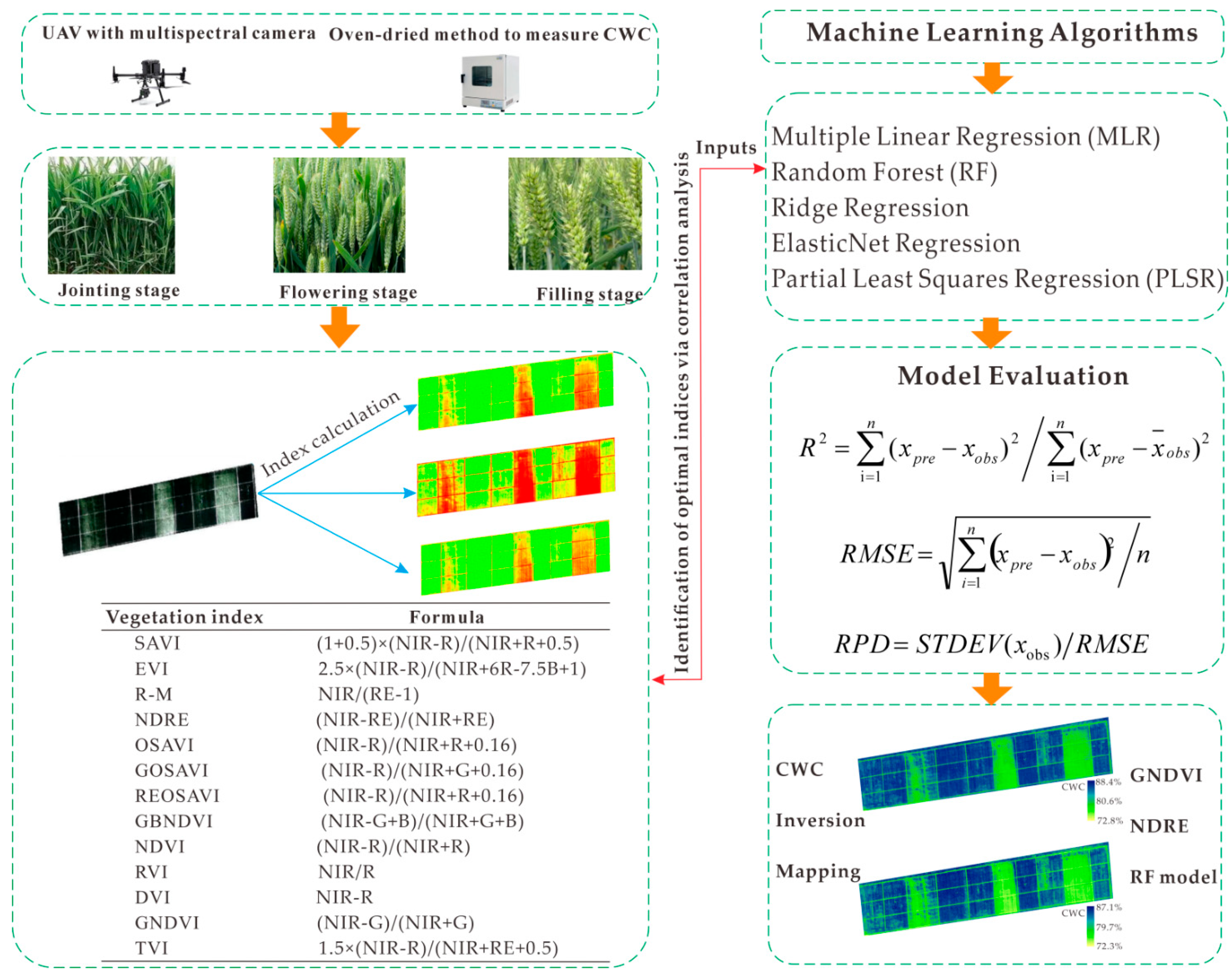

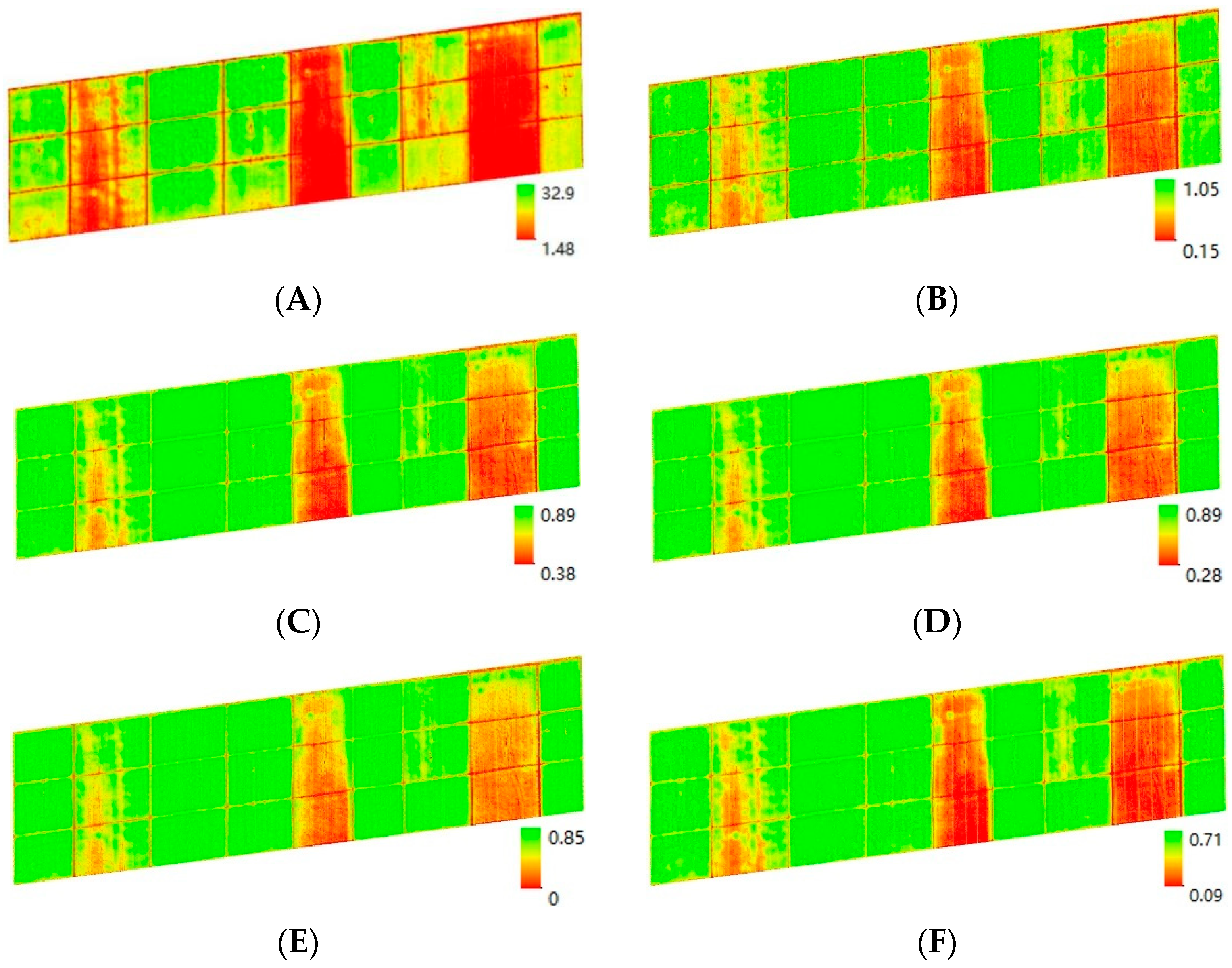
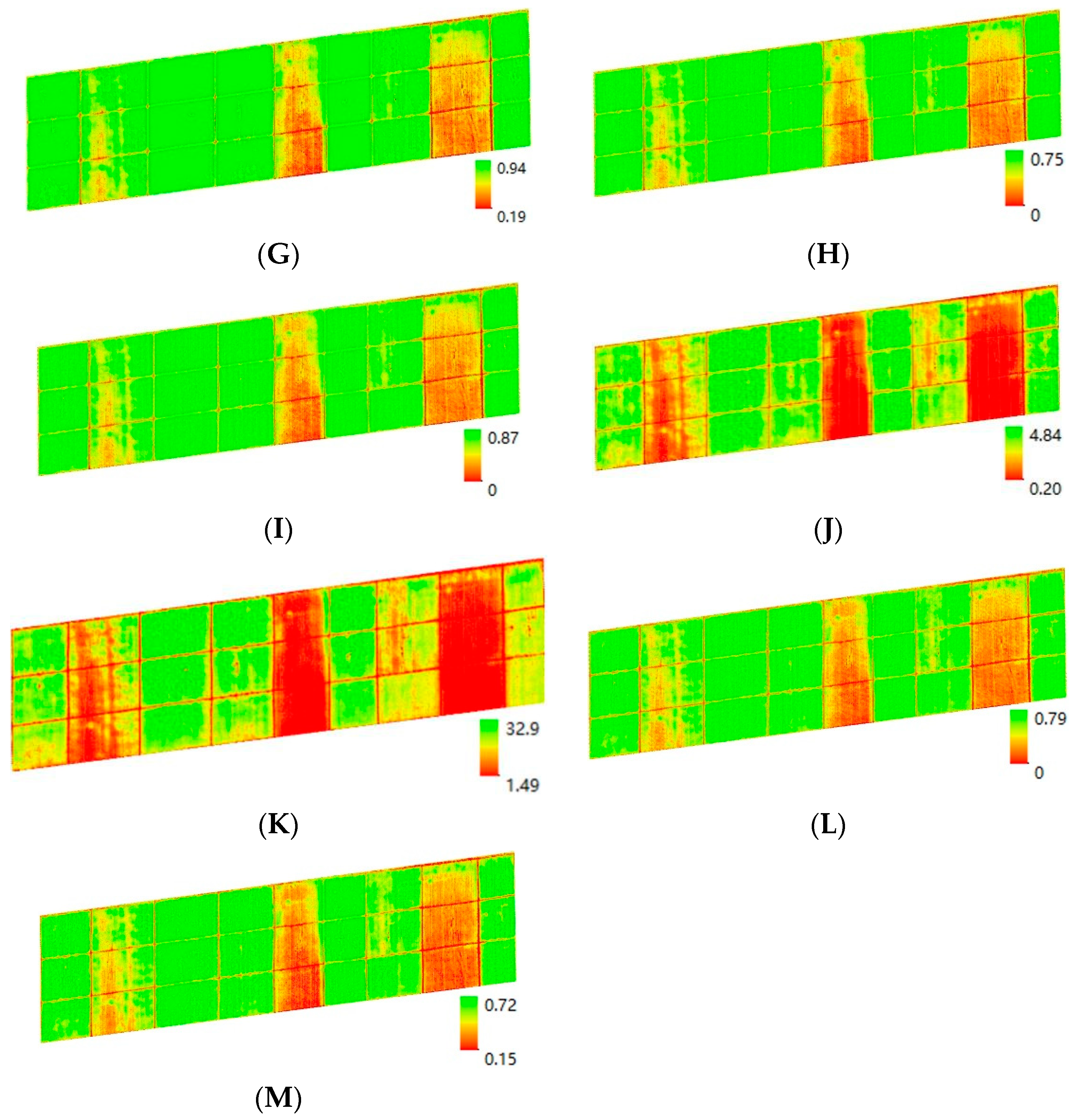
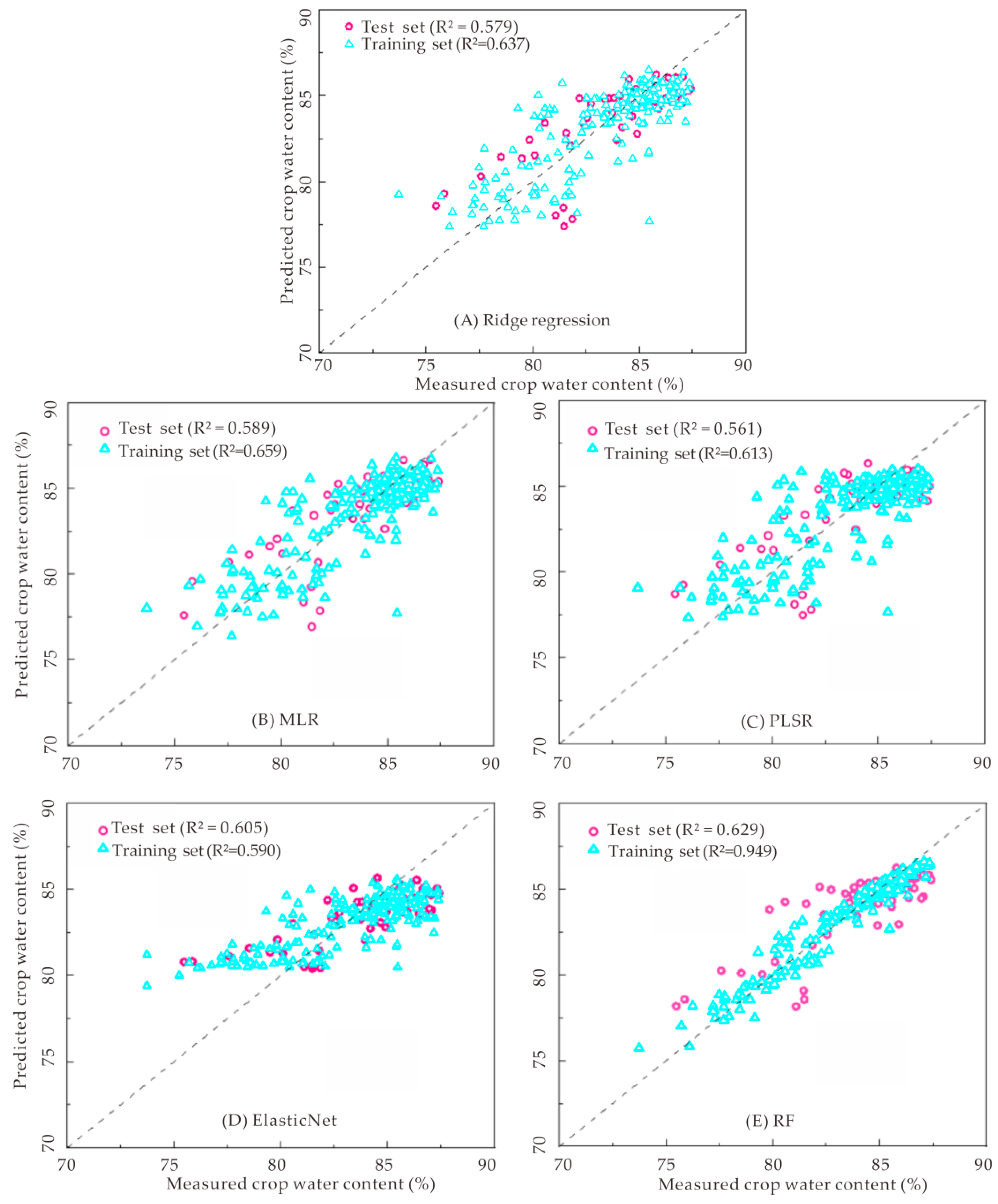

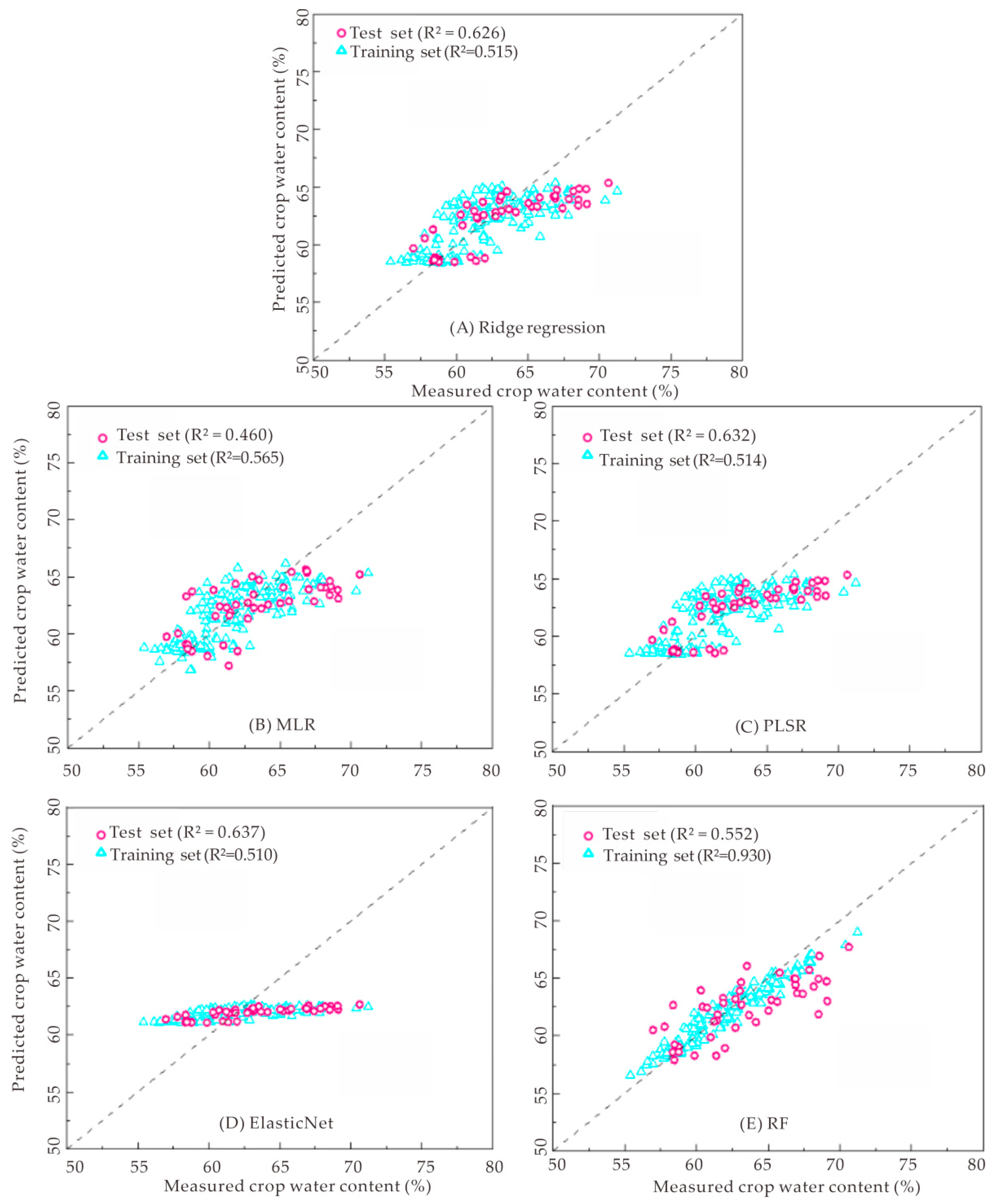
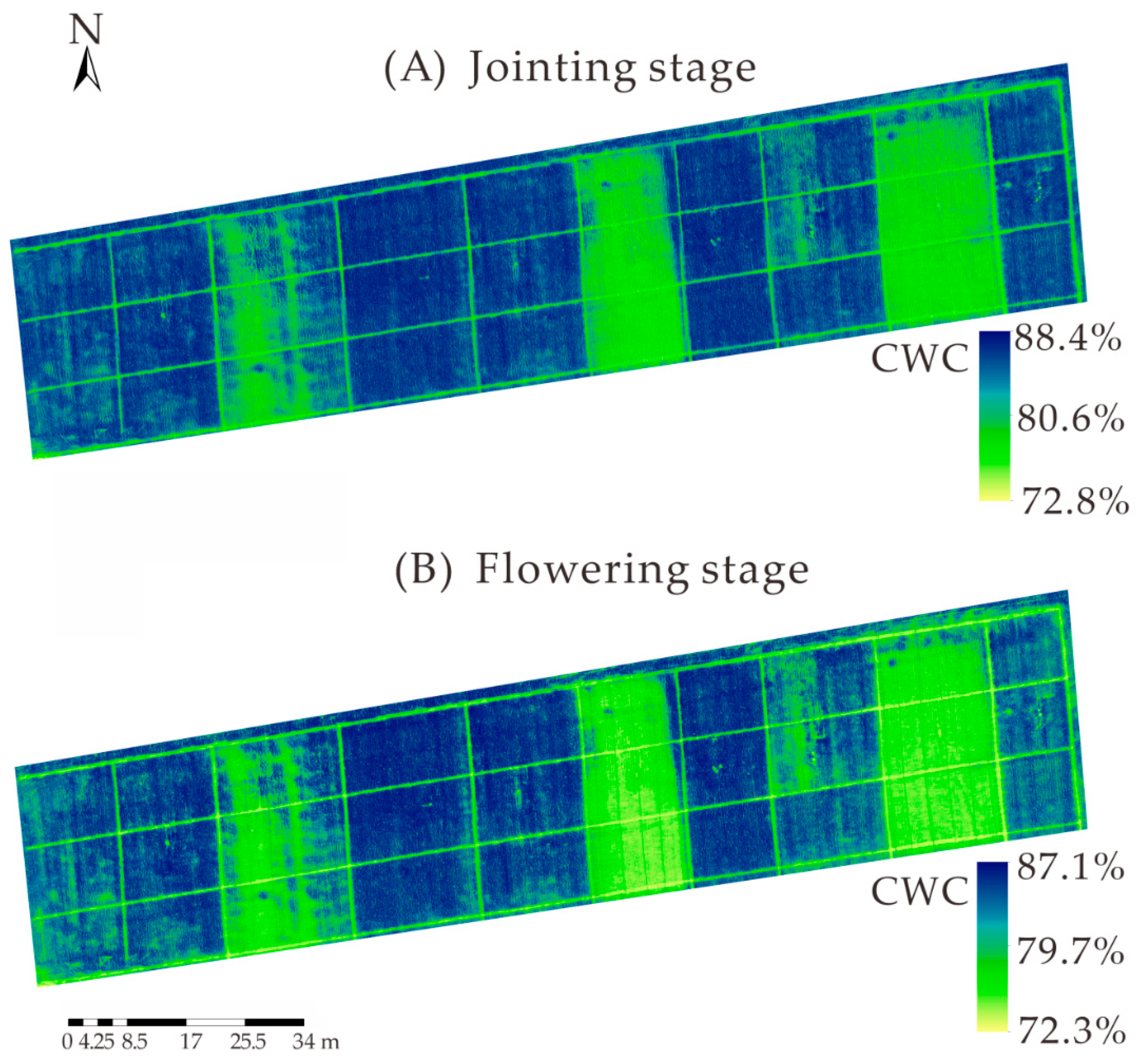
| Soil Depth (cm) | Clay (%) | Silt (%) | Sand (%) | Wilt Point (cm3 cm−3) | Field Capacity (cm3 cm−3) | SSWC 1 (cm3 cm−3) | Bulk Density (g cm−3) |
|---|---|---|---|---|---|---|---|
| 0–20 | 6.75 | 69.72 | 23.53 | 0.16 | 0.34 | 0.45 | 1.52 |
| 20–40 | 6.41 | 66.94 | 26.69 | 0.16 | 0.32 | 0.41 | 1.51 |
| 40–60 | 10.19 | 69.62 | 19.85 | 0.18 | 0.32 | 0.42 | 1.52 |
| 60–80 | 10.16 | 73.44 | 16.41 | 0.18 | 0.30 | 0.36 | 1.42 |
| 80–100 | 8.22 | 75.74 | 16.02 | 0.17 | 0.31 | 0.38 | 1.41 |
| Band | Bandwidth | Wavelength | Picture Resolution |
|---|---|---|---|
| Blue | 30 nm | 450 | 1280 × 960 |
| Green | 30 nm | 555 | 1280 × 960 |
| Red | 30 nm | 660 | 1280 × 960 |
| Red Edge 01 | 20 nm | 720 | 1280 × 960 |
| Red Edge 02 | 20 nm | 750 | 1280 × 960 |
| Near infrared | 30 nm | 840 | 1280 × 960 |
| Vegetation Index | Formula | References |
|---|---|---|
| Soil-adjusted vegetation index (SAVI) | (1 + 0.5) × (NIR − R)/(NIR + R + 0.5) | [25] |
| Enhanced vegetation index (EVI) | 2.5 × (NIR − R)/(NIR + 6R − 7.5B + 1) | [26] |
| Red edge model (R-M) | NIR/(RE − 1) | [27] |
| Normalized red edge vegetation index (NDRE) | (NIR − RE)/(NIR + RE) | [28] |
| Optimized soil-adjusted vegetation index (OSAVI) | (NIR − R)/(NIR + R + 0.16) | [29] |
| Green optimized soil-adjusted vegetation index (GOSAVI) | (NIR − R)/(NIR + G + 0.16) | [30] |
| Red edge optimized soil-adjusted vegetation index (REOSAVI) | (NIR − R)/(NIR + R + 0.16) | [31] |
| Normalized blue-green band difference vegetation index (GBNDVI) | (NIR − G + B)/(NIR + G + B) | [32] |
| Normalized difference vegetation index (NDVI) | (NIR − R)/(NIR + R) | [33] |
| Ratio vegetation index (RVI) | NIR/R | [34] |
| Difference vegetation index (DVI) | NIR − R | [35] |
| Green normalized difference vegetation index (GNDVI) | (NIR − G)/(NIR + G) | [32] |
| Triangular vegetation index (TVI) | 1.5 × (NIR − R)/(NIR + RE + 0.5) | [36] |
| Growth Stages | Models | Training Set | Test Set | ||||
|---|---|---|---|---|---|---|---|
| R2 | RMSE (%) | RPD | R2 | RMSE (%) | RPD | ||
| Jointing | MLR | 0.659 | 2.527 | 1.721 | 0.589 | 2.821 | 1.578 |
| RF | 0.949 | 1.141 | 4.122 | 0.629 | 2.035 | 2.041 | |
| ElasticNet | 0.613 | 2.258 | 1.405 | 0.561 | 2.424 | 1.474 | |
| Ridge | 0.637 | 2.761 | 1.661 | 0.579 | 2.652 | 1.553 | |
| PLSR | 0.613 | 2.838 | 1.625 | 0.561 | 2.962 | 1.524 | |
| Flowering | MLR | 0.659 | 2.374 | 1.521 | 0.82 | 3.710 | 1.003 |
| RF | 0.943 | 1.256 | 3.403 | 0.769 | 3.002 | 2.011 | |
| ElasticNet | 0.622 | 3.871 | 1.121 | 0.830 | 4.207 | 1.038 | |
| Ridge | 0.647 | 2.924 | 1.444 | 0.844 | 3.684 | 1.446 | |
| PLSR | 0.643 | 2.596 | 1.441 | 0.835 | 3.938 | 1.442 | |
| Filling | MLR | 0.565 | 2.583 | 1.713 | 0.460 | 1.149 | 2.367 |
| RF | 0.930 | 1.574 | 3.935 | 0.552 | 1.286 | 2.083 | |
| ElasticNet | 0.510 | 2.351 | 1.574 | 0.637 | 1.476 | 2.145 | |
| Ridge | 0.515 | 2.862 | 1.695 | 0.626 | 1.942 | 2.544 | |
| PLSR | 0.514 | 2.178 | 1.689 | 0.632 | 1.729 | 2.472 | |
Disclaimer/Publisher’s Note: The statements, opinions and data contained in all publications are solely those of the individual author(s) and contributor(s) and not of MDPI and/or the editor(s). MDPI and/or the editor(s) disclaim responsibility for any injury to people or property resulting from any ideas, methods, instructions or products referred to in the content. |
© 2024 by the authors. Licensee MDPI, Basel, Switzerland. This article is an open access article distributed under the terms and conditions of the Creative Commons Attribution (CC BY) license (https://creativecommons.org/licenses/by/4.0/).
Share and Cite
Zhang, Z.; Dou, G.; Zhao, X.; Gao, Y.; Liu, S.; Qin, A. Inversion of Crop Water Content Using Multispectral Data and Machine Learning Algorithms in the North China Plain. Agronomy 2024, 14, 2361. https://doi.org/10.3390/agronomy14102361
Zhang Z, Dou G, Zhao X, Gao Y, Liu S, Qin A. Inversion of Crop Water Content Using Multispectral Data and Machine Learning Algorithms in the North China Plain. Agronomy. 2024; 14(10):2361. https://doi.org/10.3390/agronomy14102361
Chicago/Turabian StyleZhang, Zhenghao, Gensheng Dou, Xin Zhao, Yang Gao, Saisai Liu, and Anzhen Qin. 2024. "Inversion of Crop Water Content Using Multispectral Data and Machine Learning Algorithms in the North China Plain" Agronomy 14, no. 10: 2361. https://doi.org/10.3390/agronomy14102361
APA StyleZhang, Z., Dou, G., Zhao, X., Gao, Y., Liu, S., & Qin, A. (2024). Inversion of Crop Water Content Using Multispectral Data and Machine Learning Algorithms in the North China Plain. Agronomy, 14(10), 2361. https://doi.org/10.3390/agronomy14102361







